
Tropaeolum, commonly known as nasturtium, is a genus of roughly 80 species of annual and perennial herbaceous flowering plants. It was named by Carl Linnaeus in his book Species Plantarum, and is the only genus in the family Tropaeolaceae. The nasturtiums received their common name because they produce an oil similar to that of watercress.

Tropaeolum tuberosum is a species of flowering plant in the family Tropaeolaceae, grown in the Andes, particularly in Peru and Bolivia, and to a lesser extent in Ecuador as well as in some areas of Colombia, for its edible tubers, which are eaten cooked or roasted as a vegetable. It is a minor food source, especially to native Amerindian populations. Mashua is a herbaceous perennial climber growing to 2–4 m (7–13 ft) in height. It is related to garden nasturtiums, and is occasionally cultivated as an ornamental for its brightly coloured tubular flowers.
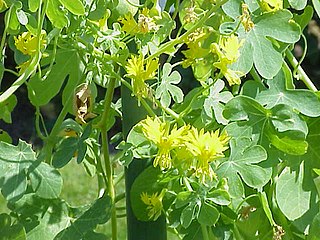
Tropaeolum peregrinum, the canary-creeper, canarybird flower, canarybird vine, or canary nasturtium, is a species of Tropaeolum native to western South America in Peru and possibly also Ecuador.

Tropaeolum majus, the garden nasturtium, nasturtium, Indian cress or monks cress is a species of flowering plant in the family Tropaeolaceae, originating in the Andes from Bolivia north to Colombia. An easily-grown annual with disc-shaped leaves and brilliant orange or red flowers, it is of cultivated, probably hybrid origin. It is not closely related to the genus Nasturtium.
Tropaeolum asplundii is a species of plant in the Tropaeolaceae family. It is endemic to Ecuador. Its natural habitat is subtropical or tropical moist montane forests.
Tropaeolum brideanum is a species of plant in the Tropaeolaceae family. It is endemic to Ecuador. Its natural habitat is subtropical or tropical moist montane forests.
Tropaeolum carchense is a species of plant in the Tropaeolaceae family. It is endemic to Ecuador. Its natural habitat is subtropical or tropical high-altitude grassland.
Tropaeolum huigrense is a species of plant in the Tropaeolaceae family. It is endemic to Ecuador. Its natural habitat is subtropical or tropical moist montane forests.
Tropaeolum leonis is a species of plant in the Tropaeolaceae family. It is endemic to Ecuador. Its natural habitat is subtropical or tropical moist montane forests.
Tropaeolum magnificum is a species of plant in the Tropaeolaceae family. It is endemic to Ecuador. Its natural habitats are subtropical or tropical moist montane forests and subtropical or tropical high-altitude grassland.
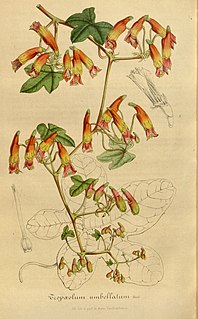
Tropaeolum umbellatum is a species of plant in the Tropaeolaceae family. It is endemic to Ecuador. Its natural habitat is subtropical or tropical moist montane forests.

Leptophobia eleone, the silky wanderer or eleone white, is a butterfly in the family Pieridae. It is found from Colombia to Bolivia. The habitat consists of cloud forests.

Tropaeolum speciosum, the flame flower or flame nasturtium, is a species of flowering plant in the family Tropaeolaceae native to Chile, where it is known locally as coralito, quintralito, or voqui.
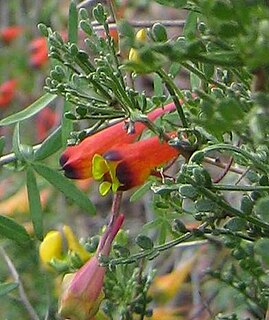
Tropaeolum tricolor, the three-coloured Indian cress or Chilean nasturtium, is a species of perennial plant in the family Tropaeolaceae. It is endemic to Chile, where it is called soldadito rojo and relicario.

Tropaeolum polyphyllum is a species of flowering plant in the nasturtium family Tropaeolaceae. It is endemic to mountainous regions of Chile and Argentina where it is called in Spanish soldadito grande de la cordillera.

Tropaeolum brachyceras is a species of perennial plant in the Tropaeolaceae family. It is endemic to mountainous regions of Chile.
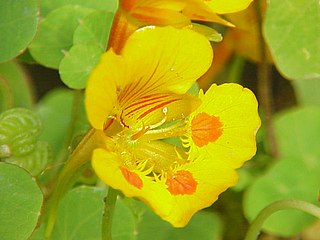
Tropaeolum minus, the dwarf nasturtium is a species of perennial plant in the Tropaeolaceae family. It is endemic to mountainous regions of Ecuador and Peru.
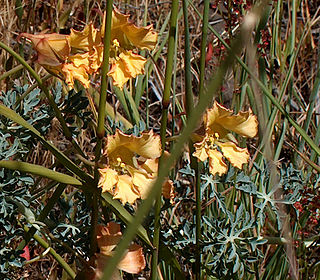
Tropaeolum incisum is a species of nasturtium, with flaring petals in shades of yellow and peach, when still in bud and on the outside darker, more orange-brown and sometimes stained purple, with creeping or climbing stems, in the wild up to about 60 cm long with deeply divided, blue-grey leaves, with undulating lobes, that grows on the dry eastern side of the southern Andes mountains.
Tropaeolum beuthii is a species of flowering plant in the family Tropaeolaceae, native to Northern Chile. Growing to 1 m (3.3 ft) in height, it is a tuberous summer-dormant climber. It belongs to the same genus as the more familiar annual nasturtium of gardens, Tropaeolum majus.

Tropaeolum hookerianum is a species of perennial plant in the Tropaeolaceae family. It is found in Chile.













